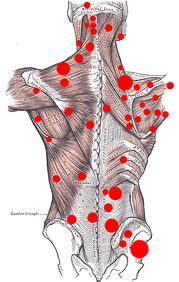Conditions Treated
Our Comprehensive Treatment Techniques
Treatment Techniques
- Manual Therapy
- Electrotherapy
- Acupuncture & Dry Needling
- Ultrasound Therapy
- Spinal Decompression/Traction Therapy
- Soft Tissue Mobilization Therapy
Pediatric Therapy
- Neuro Development Therapy
- Gait & Balance Training
- Autism
- Development Delay
- Attention Deficit Hyperactive Disorder
- Gross Motor Development
- Sensory Integration Therapy
- Strengthening and Range of Motion Exercises
- Down Syndrome
- Postural and Movement Control
- Cerebral Palsy
- Developmental Skills Evaluation
Conditions Treated
RSI (Repetitive strain injury)

Myofascial Pain Syndrome
Myofascial pain syndrome (MPS), also known as chronic myofascial pain, is characterized by pain caused by multiple trigger points and fascial constrictions.

Fibromyalgia
Fibromyalgia (fibro- fibrous tissue, Myo – muscle, algia – pain) is characterized by chronic widespread pain. Its exact cause is unknown but is believed to involve psychological, genetic, neurobiological, and environmental factors. Symptoms of fibromyalgia are not restricted to pain, leading to the use of the alternative term fibromyalgia syndrome. Other symptoms include debilitating fatigue, sleep disturbance, and joint stiffness.

Carpal Tunnel Syndrome
Carpal tunnel syndrome (CTS) is a median entrapment neuropathy that causes paresthesia, pain, numbness, and other symptoms in the distribution of the median nerve due to its compression at the wrist in the carpal tunnel.

Thoracic Outlet Syndrome:
Thoracic outlet syndrome (TOS) involves compression at the superior thoracic outlet, where excess pressure is placed on a neurovascular bundle passing between the anterior scalene and middle scalene muscles. It can affect one or more of the nerves that innervate the upper limb and/or blood vessels as they pass between the chest and upper extremity. Specifically, it affects the brachial plexus, the subclavian artery, and - rarely - the subclavian vein, which does not normally pass through the scalene hiatus.
Sports Injuries

Lateral Ankle Sprain
A sprained ankle, also known as an ankle sprain, twisted ankle, rolled ankle, floppy ankle, ankle injury, or ankle ligament injury, is a common medical condition where one or more of the ligaments of the ankle are torn or partially torn. When a sprain occurs, blood vessels leak fluid into the tissue surrounding the joint. White blood cells responsible for inflammation migrate to the area, and blood flow increases as well. Along with this inflammation, swelling from the fluid and pain are experienced. The nerves in the area become more sensitive when the injury is suffered, so pain is felt as throbbing and will worsen if there is pressure placed on the area. Warmth and redness are also seen as blood flow is increased. Also present is a decreased ability to move the joint, and difficulty using the affected leg.

Anterior Cruciate Ligament Injury
Ligament injuries in the knee, such as an anterior cruciate ligament (ACL) injury, are dreaded by professional and amateur athletes alike. They can be painful and debilitating, even permanently changing your lifestyle.

Rotator Cuff Tear
The rotator cuff is a group of four tendons and muscles that converge around the top of the humerus, the upper arm bone above the elbow. Together, they form a "cuff" that both holds your arm in place and allows it to move in different directions. While your shoulder is one of your most mobile joints, it's also somewhat weak. Too much stress or too many fastballs can cause partial tears and swelling in the tendons of the rotator cuff. Abrupt stress may even cause one of the tendons to pull away from the bone or tear in the middle of the tendon. Rotator cuff tears are sometimes incorrectly called "rotary cuff tears.

Rotator Cuff Tear
- Dislocated Shoulder
- Golfer's Elbow
- Groin Pull
- Hamstring Injuries
- Head Injury
- Muscle Strain
- Posterior Cruciate Ligament Injury
- Repetitive Motion Injuries
- Running Injuries
- Shin Splints
- Skier's Thumb
- Soreness After Exercise
- Tailbone Injuries
- Tendon Injuries
- Tennis Elbow
- Tommy John Surgery
- Turf Toe
- Workout Injuries

Orthopedic conditions

Lumbar Spondylosis
Lumbar spondylosis is a term referring to degenerative osteoarthritis in the joints of the lumbar vertebrae (lower back). This progressive degeneration leads to narrowing of the space between the two adjacent vertebrae
This involves the joints between the two vertebrae (interfacetal joints). If severe, it causes pressure on the nerve roots, resulting in sensory and/or motor symptoms such as pain, numbness, and muscle weakness.

Frozen Shoulder
Frozen shoulder, medically referred to as adhesive capsulitis, is a disorder in which the shoulder capsule, the connective tissue surrounding the glenohumeral joint of the shoulder, becomes inflamed and stiff, greatly restricting motion and causing chronic pain.

Osteoarthritis
Osteoarthritis (OA), also known as degenerative arthritis or degenerative joint disease, is a group of mechanical abnormalities involving degradation of joints, including articular cartilage and subchondral bone.

Post operative conditions
- Capsulorrhaphy
- Total Knee Replacement
- Anterior Cruciate Ligament Repair
- Posterior Cruciate Ligament Repair
- Acromioplasty
- Total Hip Replacement
- Arthrodesis
